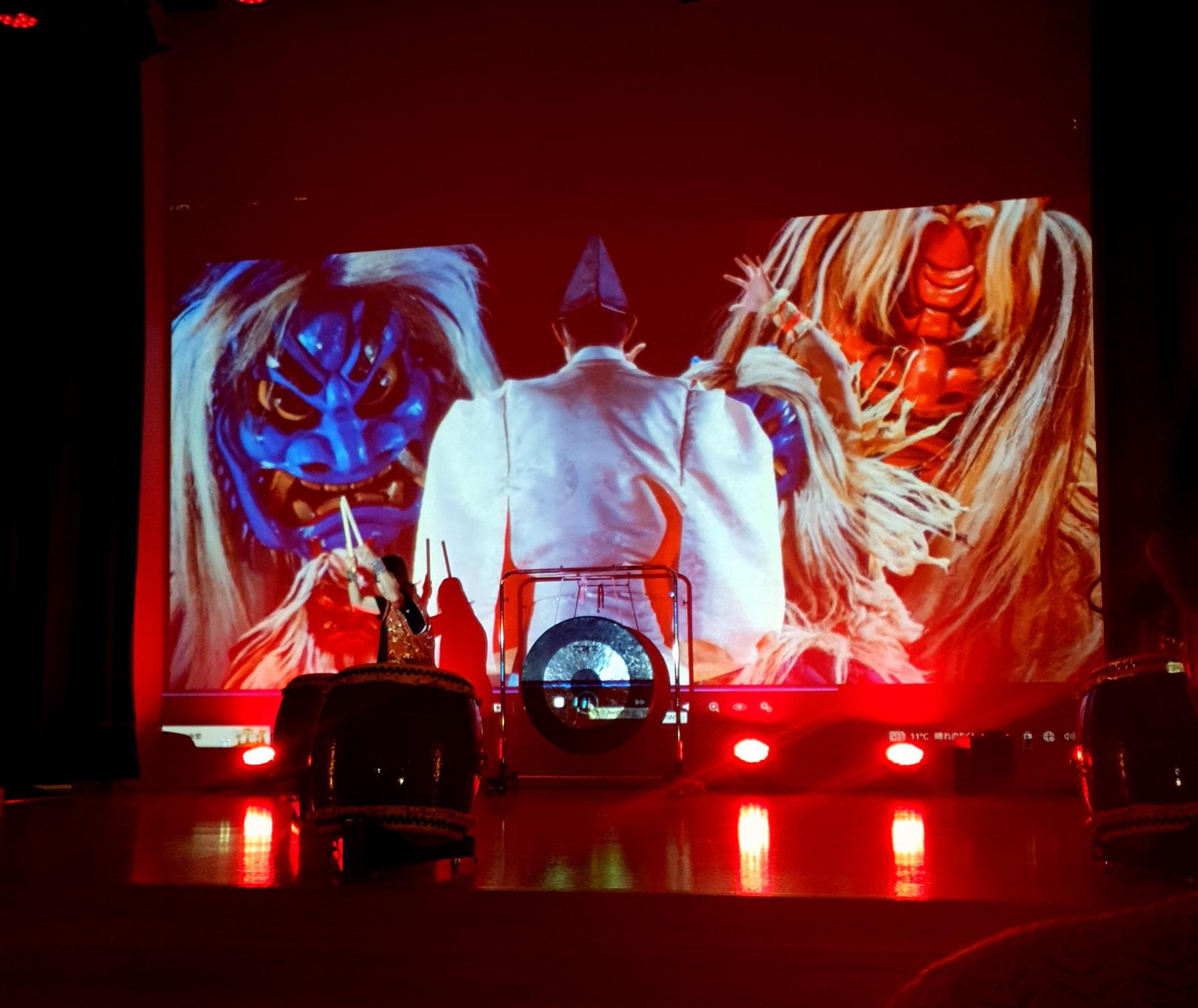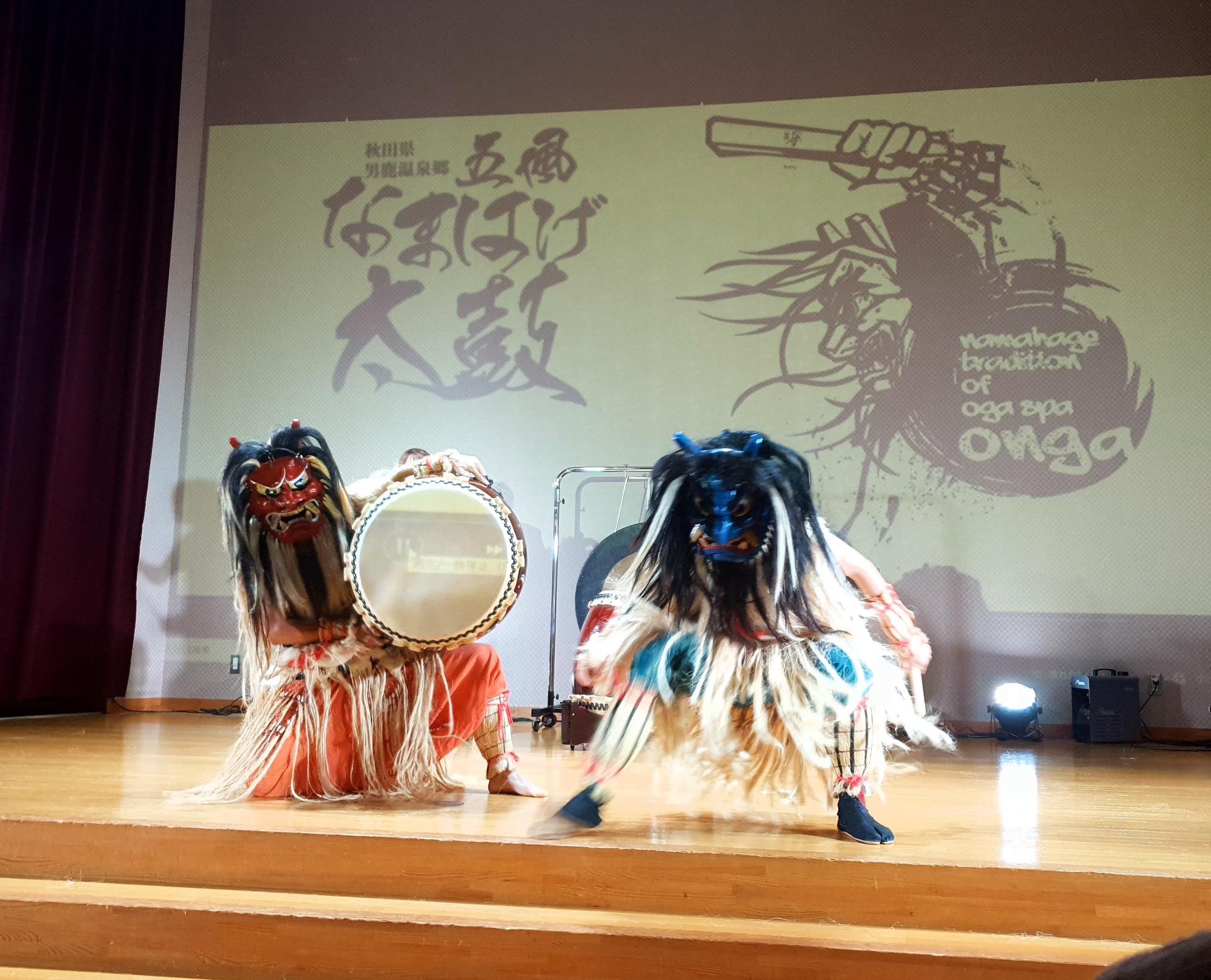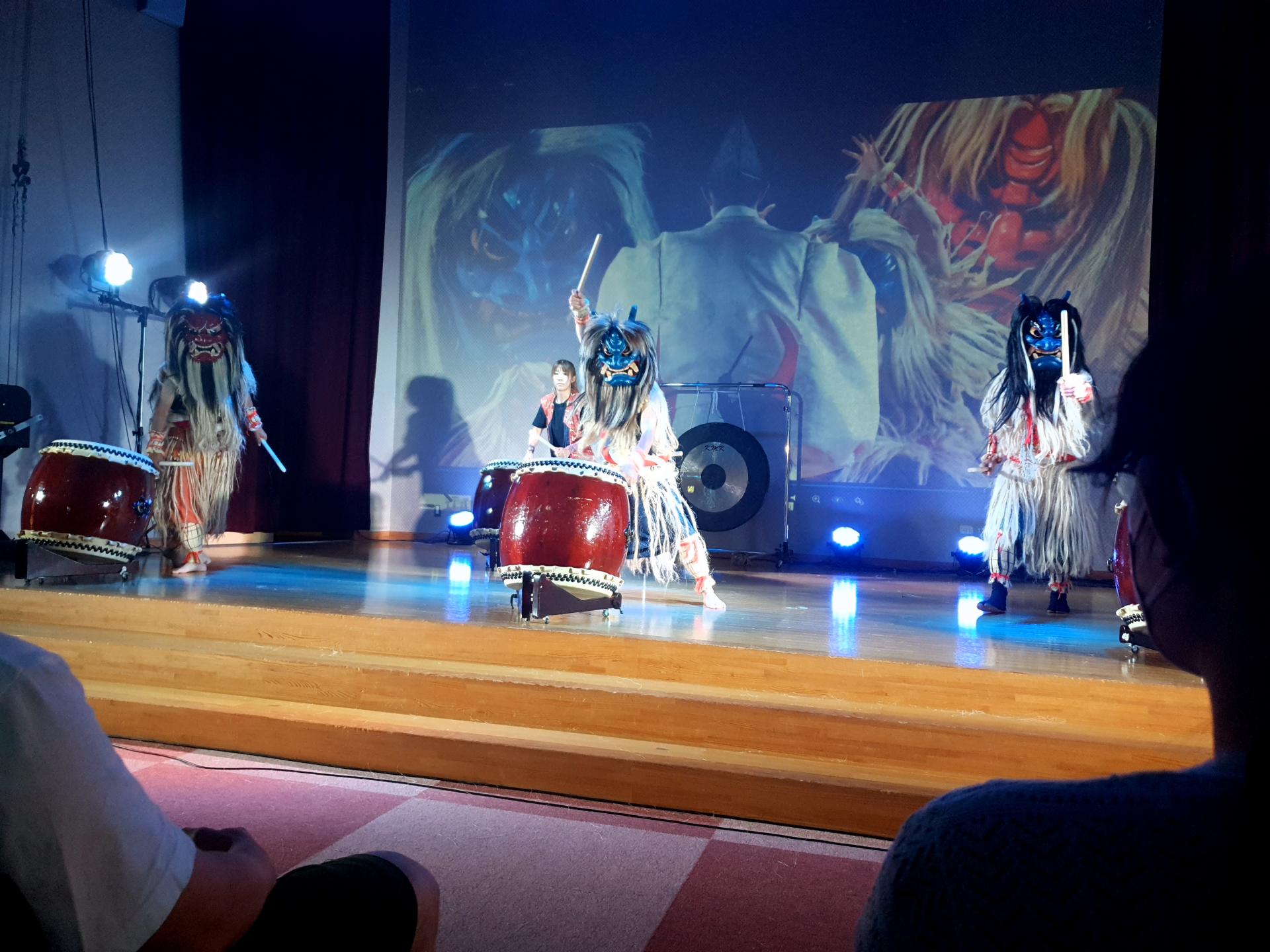
The room is dark, the crowd tense, and a spotlight illuminates a woman, standing alone on stage. Before her is a taiko drum and in her hands two bachi drumsticks as thick as broom handles. She lowers her stance and raises her hands high above her head, bachi pointing straight up towards the heavens. Her voice cries out, piercing the silence of the crowd, and with full force she brings down the bachi, unleashing the thunder hidden within the drum. The drumming steadily grows faster, then slower, then faster again, reaching a crescendo and stopping completely. The lone drummer then breaks into a steady beat and the lights on stage flash blue and red as growling, loud voices can be heard from every direction of the room.
“Are there any bad children?! Are there any lazy children?!”
Suddenly, the doors behind the crowd fly open as three Namahage come stomping into the hall. They inspect the amazed audience as they make their way to the stage. Prowling, like hungry lions circling their prey, they move towards their drums and draw their bachi. The drumbeats are primal and animalistic, the stances and movements powerful. They jump off the stage and mingle into the crowd, eliciting astound gazes from the adults and fearful but curious looks from the children clenched up to their parents. In a display of their godly might, a Namahage hoists one of the hefty taiko drums above its head, and a furious drum solo begins, which will leave the audience with lingering excitement long after the performance is over.
As the show nears its end, two of the Namahage disappear through the door they came from, and the remaining Namahage grabs a Shinto staff, and like a priest waves it over the congregation. Despite their terrifying appearance, the Namahage are no demons, but gods that drive out evil, and this final ritual is meant to cleanse the audience of whatever malignant energies might be clinging to them. The last Namahage then disappears out the back of the stage, and the lone female drummer draws the performance to a close with a final crescendo of the drum.
Since I first learned about the Namahage tradition of Oga Peninsula years ago, I have been itching to visit Akita Prefecture. Last year, I was offered the position as a CIR close to Oga and have since then practically become a regular at the Namahage Museum. After I moved to Akita, I also joined a taiko group, which has hands down been one of the coolest things I've ever tried. Imagine then my gleeful joy, when I learned that there’s a group that does taiko in Namahage costumes on Oga.
Since then, I have seen the Namahage Taiko group perform on several occasions, both in their special performance hall at Oga Onsen, at Oga Namahage Rock Festival, at the Namahage Sedo Matsuri, and even in front of supermarkets. Suffice to say, I’m head over heels for the Namahage Taiko group.
The group itself was started in 1987 to showcase and invigorate the Namahage tradition. Originally, Namahage has had nothing to do with taiko, but it has turned out to be a match made in heaven. Flash forward, and the overall group has developed into at least two smaller crews, Onga Namahage Taiko, and Namahage Satokagura. Onga Namahage Taiko operates mainly on Oga, specifically at the onsen area where there is a special performance hall for the group. These part-time drumming champs are all about those after-work beats, putting in serious hustle for not-so-serious pay.
On the flip side, Namahage Satokagura is the squad that's taking the party beyond Oga's borders, drumming their way across Akita, around Japan, and even abroad. It goes without saying, that these drumming dynamos do it as a full-time gig.
Now, here’s where it gets interesting. I managed to land an interview with two members of the Onga Namahage Taiko group. So, I drove my car to Oga Onsen, watched the taiko performance, and then waited inside the hall for the rest of the guests to leave. After it had emptied out, the woman who had been drumming on stage came in together with the man who had been selling tickets in the lobby. The three young men who had just finished their Namahage performance were busy cleaning up and getting ready to head home.
As we sat down together, I learned that the woman’s name was Yuri and that she was from Oga City. The man, a Nyūdōsaki resident, was named Ryō and although he was currently in charge of ticket sales, he used to be in the show, still making appearances on occasion.
I asked Yuri and Ryō about how they entered the group, and they told me that it is roughly the same for all members – many start doing taiko in elementary and middle school, before entering the Namahage Taiko club in high school. Apparently, the Namahage Taiko club is directly connected to the Namahage Taiko group and works as a way to keep the group going with fresh members. As Yuri told me, she had to stop doing taiko for a while after finishing high school because she had to join the workforce, which is a common pattern for the members. Even now, years later, she still has to come straight from work in order to do performances, which are in essence a hobby for her. But she loves to see the smiling audience, so she gladly does it, despite not making money from it. Currently, the group has fifteen active members.
I then shifted my focus to the music and asked them about the pieces they play. After a bit of calculations, they told me that the group has a total of ten pieces in its roster. The most iconic and famous one is without a doubt Shinzan (Arrival of the Gods), which is played in Namahage costumes. However, they both agreed that their favorite song to play, is one called Shimakaze (Island Wind). Currently, they play this song at Oga Onsen after playing Shinzan and changing out of the Namahage costumes. It is lighthearted, has a fast tempo, and the smiles of the performers is a stark contrast to the scary faces of the Namahage.
As the conversation fell on the costumes, I asked them about something else that had always been on my mind. Do women ever perform the role of Namahage on the stage? Surely, I thought, for large events, such as Namahage Sedo Matsuri, they must need as many drumming Namahage as possible. And seeing as it is a performance made to entertain and lure tourists to Oga, the rule that only men can don the mask of the Namahage wouldn’t be strictly kept.
Ryō answered my question with a stern face, saying that the women in the group are never allowed to wear the masks. Because, even though it is a performance for tourists, the Namahage is still a very sacred thing to the people of Oga. The only time women are allowed to put on one of the masks, is tourists who come to the Namahage Museum where they can try it on. Instead of playing the Namahage, the women assume the role of Miko – shrine maidens responsible for summoning the Namahage and laying down a steady drumbeat. This does not take away from their performance though, as keeping a steady and fast beat is both technically and physically demanding.
Being a taiko drummer myself, I can appreciate how demanding it can be to hold a fast and steady drumbeat on the taiko, so I asked Yuri if she wasn’t tired. She told me to look at her name, which I had asked her to write down at the beginning of the interview for the sake of knowing the kanji. The hand that had written the symbols was clearly shaky.

This brought me to my next question: What is it like to perform in the costume, and what sets Namahage Taiko apart from other forms of taiko? Ryō immediately told me that it is extremely limited how much they can see out of the masks, and that the sheer size of it makes drumming difficult. He added that many apprentices hit the mask with the bachi while practicing, sometimes breaking off the horns and teeth. Doing the growling voice also takes quite the toll on the throat, which is why nowadays, they use a prerecorded voice for most of the performance.
Concerning what sets Namahage apart from other taiko group, neither Ryō nor Yuri had much to say. Being a taiko drummer myself, I can say that there are no hard rules for how to do taiko drumming. Nonetheless, the vast majority of taiko groups drum the same way – wide, open, and orderly stances, where you never sway or lean. The bachi go up and down in a straight and orderly fashion, and you must remain stationary at your taiko. Although normal taiko drumming is an awesome sight to behold, it is very much orderly. Namahage taiko, on the other hand, is very different. The best way to describe it, would be to compare it to a heavy metal guitarist, coupled with how a tiger might pace around in a cage. They jump, lean over the taiko, drum at strange angles, and seem to always be prowling around the stage, looking menacingly at the audience.
I followed up by asking who decides how they move and drum. They said that the group leader, Ishikawa Daisuke, makes all the creative decisions for the group, but no one has decided how they have to move. Everyone decides for themselves. As long as it is “like a Namahage” it is fine.
Ryō, being the only one of the two to drum in the Namahage attire, and also performing the role of Namahage on New Year’s Eve, added that, when putting on the mask, one has to move like a Namahage. It is not a conscious choice. The way you walk, the way you drum, the way you turn and look at the people, it all comes on its own. It is not something you chose to do; it is something you are compelled to do. You don’t pretend to be a Namahage; you become a Namahage.
Returning to a slightly lighter topic, I asked the two drummers what their favorite part of any performance is. Yuri said that her favorite thing, is when she ends a song with her bachi high in the air, and the crowd cheers and claps. Ryō answered that he prefers a specific moment in the song Shimakaze, where all the drummers look at each other. As he puts it, in that moment, it is as if all their hearts beat as one.
Finally, I had one question for them; What do you want to say to all the international readers out there, who might not have gone to Oga Onsen to see the Namahage Taiko performance yet?
Yuri encouraged everyone to come, have a dip in their onsen and taste the delicious food. Ryō followed up, jokingly saying that they should ask for Yuri’s homemade curry. Laughing, Yuri smacked him on the shoulder, asking who would take responsibility if a bunch of foreigners suddenly showed up asking for her curry.
In a more serious tone, Ryō then added something that I, as a fellow taiko drummer, agree with in every way:
「太鼓は見る物とか聞く物じゃなくて、体験するものです」- Taiko is not something you see or hear. It is something you experience.
The most important word here being 体験 (taiken), denoting an experience had with the body. He elaborated that it is rare that a microphone can capture the whole sound of a taiko drum and for speakers to replicate it. Taiko must be experienced live and up close. It can be felt on the skin and reverberates inside the lungs. Just like taiko is an instrument that is played using the whole body, it is an instrument that can only be properly experienced with the whole body.
Ryō finished by extending an invitation, saying, “Please, come to Oga Onsen, and experience taiko.”


